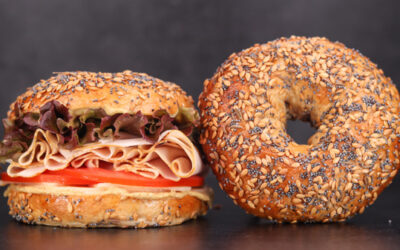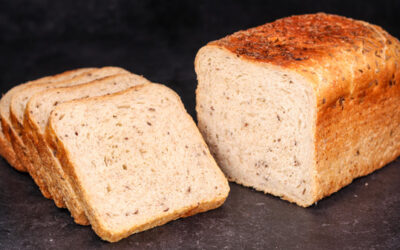Making a 100% hydration bread has been on my list forever. But I always hesitated because I thought it would be super messy and difficult.
But the King Arthur Baking website had an awesome guide on this. So, I adapted the recipe to fit my style and it worked out perfectly.
There is no kneading and that is what makes this extra simple and quite fun to make.
The gluten is developed by a series of folds during bulk fermentation. We create tension which helps the dough hold the fermentation gases effective. The water content gives this bread that distinctly bubbly crumb. It is super light and airy with a bubbly crumb.
There is one important piece of equipment required to make this happen – a large solid base to bake it on. I used a baking steel, but a baking stone should work too. A hot surface is required for the dough to jump up as it hits the oven.
This recipe makes two large loaves enough for 4 huge sandwiches. To make more multiply the amount of ingredients and divide the dough into more loaves.
Watch the video down below for detailed instructions.
Ingredients
250g (8.8oz) high protein white bread flour
2g (0.07oz) instant dry yeast or 2.4g (0.08oz) active dry yeast or 6g (0.21oz) fresh yeast
5g (0.17oz) salt
250g (8.8oz) warm water *
*To learn more about dough temperature control click here.
15g olive oil to grease the tray
Method
- In a large bowl combine the water, yeast, and salt. Mix well to dissolve the salt and hydrate the yeast.
- Add the flour and mix until there is no dry flour left. Continue mixing for another 30 seconds to make sure there are no lumps. *Desired dough temperature 24C – 25C (75F – 77F). If your dough is warmer, then it will ferment more rapidly. If it is cooler, then it will take longer. Adjust proofing time accordingly.
- Grease a small baking tray with the oil. Pour the dough into the tray.
- Cover and rest for 20 minutes.
- Fold #1. The first fold is called a bowl fold. Fold the dough going around in a circle until it becomes somewhat tight.
- Rest for 20 minutes.
- Fold #2. From now perform coil folds. Lift the dough and fold it underneath itself on all sides.
- Rest for 20 minutes.
- Fold #3.
- Rest for 20 minutes.
- Fold #4.
- Cover and ferment for 1 hour.
- Turn the dough out on a well-floured tray and cover the dough with more flour all over.
- Cut the dough in half and flour the cut so that it does not stick back together.
- Place the two loaves on a piece of non-stick paper with plenty of space between them.
- Final proof 1 – 1.5 hours. *During the final hour of fermentation preheat your oven and baking steel or stone to 230C (445F) fan off.
- Carefully slide the loaves in the oven. Bake for 20 minutes. Make sure the bottom is baked well. If not, then flip the loaves and bake for a few minutes longer.
Leave to cool down and enjoy!
Keep in mind that the conditions in each kitchen are different, so fermentation times may vary for you. It is up to the baker to control the bread and react accordingly.
Your oven may be different too, so your baking time may vary.
Watch the video here



